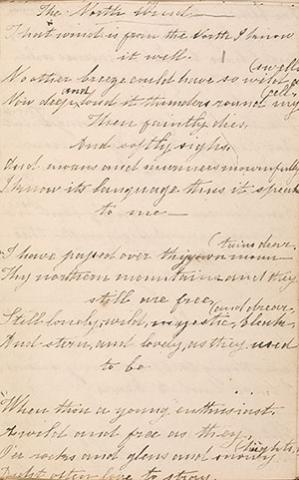
When she was in her early twenties, Anne Brontë (1820–1849) made this neat, 26-page handwritten transcription of nine poems she had composed from 1838 (beginning the week after her eighteenth birthday) through the summer of 1841. She wrote many of the poems at her family’s home, the parsonage in Haworth, West Yorkshire, in the north of England, and several while she was away working as a governess.
Brontë’s first drafts of these texts do not survive. After she had composed the poems, she recopied them into a notebook, noting the date of completion at the end of each manuscript poem and signing all but one with her full name or initials. About a half-century after Anne’s death, by which time Brontë manuscripts had become desirable to collectors, the sheets were rebound by the London firm Riviere & Son in ornately gold-tooled red leather, turning what was presumably a simple copybook into a luxury object. The sheets were trimmed very close to Brontë’s handwritten text, cutting off one word of the poem “The North Wind.” If there were any notes on the original endpapers, they were not retained.
Brontë wrote some of the poems in the voices of fictional characters of Gondal, an imaginary world she and her sister Emily had created together as children. Into their twenties, Anne and Emily continued to enjoy spinning narratives of Gondal and sometimes employed the minuscule handwriting they and their siblings Charlotte and Branwell had developed for their juvenile writings. See, for example, the end of the manuscript of “The Captive’s Dream,” where Brontë has written the “signature” of the Gondal character Alexandrina Zenobia in cursive as well as a line count, her own signature, and the date in a minute hand that resembles printed type.
Of the nine compositions included in this notebook, Brontë selected only the final one for inclusion in Poems by Currer, Ellis, and Acton Bell (London: Aylott & Jones), the book that she and her sisters Charlotte and Emily published pseudonymously in 1846. The poem, entitled “A Fragment” in the manuscript, was retitled “Self-Congratulation” for publication and its explicit Gondal references stripped away. The other eight poems in this notebook remained unpublished until fifty-three years after Brontë’s death, when they appeared in Poems by Charlotte, Emily and Anne Brontë (New York: Dodd, Mead & Co., 1902).
This manuscript was acquired by Henry Houston Bonnell (1859–1926), an ambitious American collector from Philadelphia. Bonnell bequeathed his collection to the Brontë Society, which administers the Brontë Parsonage Museum, and also provided for his widow, Helen Safford Bonnell, to retain items of her choice. During the 1960s, she began to donate those manuscripts, letters, and documents she had retained to the Morgan Library; the balance of the Bonnell collection came to the Morgan in her 1969 bequest.
Note on the text
A transcription of each page of Brontë’s manuscript text, including cancelled words, is provided. Her original spelling and capitalization are retained. An effort has been made to transcribe her punctuation marks, though many are ambiguous, and some end-of-line marks may have been cut off when her original notebook was taken apart and rebound over a century ago.
The texts of all the poems appear in Edward Chitham’s edition The Poems of Anne Brontë: A New Text and Commentary (London: Macmillan, 1979), poems 4–10 and 15–16. The Gondal poems are also published in The Brontës: Tales of Glass Town, Angria, and Gondal. Selected Writings, ed. Christine Alexander (Oxford University Press, 2010), pp. 454–65.
Introduction, notes, and manuscript transcriptions by Christine Nelson, Drue Heinz Curator of Literary and Historical Manuscripts, with contributions by Brooke Krancer, RealArts@Penn intern, 2019. We acknowledge with gratitude the work of scholars Edward Chitham and Christine Alexander.
Anne Brontë, 1820-1849
Collection of poems : autograph manuscript signed : [Haworth], 1838 Jan. 24-1841 Aug. 19
The Henry Houston Bonnell Brontë Collection. Bequest of Helen Safford Bonnell, 1969
MA 2696.5
